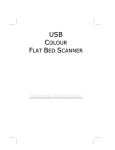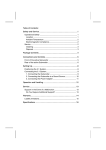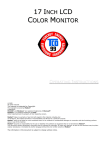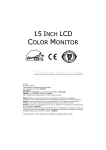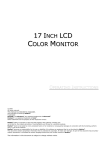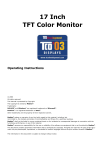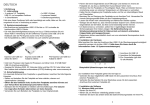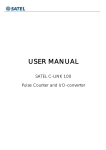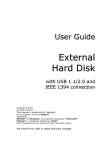Download Medion External hard disk Instruction manual
Transcript
Instruction Manual MD 90046 HDD2Go -External Hard Disk With USB 2.0 Connectivity (Backward USB 1.1 Compatible) Copyright © 2005 All rights reserved. This manual is protected by Copyright. MEDION® owns the Copyright. Trademarks: MS-DOS® and Windows® are registered trademarks of Microsoft®. Pentium® is a registered trademark of Intel®. Other trademarks are the property of their respective owners. We reserve the right to make technical changes without prior notice. Table of Contents: Safety instruction ................................................................... 1 Safety and installation .......................................................... 1 Electromagnetic compatibility/ Conformity with norms............... 2 Cleaning ............................................................................. 3 Recycling and disposal.......................................................... 3 Data security ...................................................................... 3 Introduction .......................................................................... 4 What’s included ................................................................... 4 System requirements ........................................................... 4 Setting up ............................................................................. 5 Connecting the cables .......................................................... 5 Installing the hard disk ......................................................... Before you install your hard disk ......................................... Partitioning programs ........................................................ Partitioning the drive ......................................................... Formatting the drive .......................................................... Choosing between NTFS, FAT, and FAT32 ............................. 6 6 6 6 6 7 Deleting hard disks from the system....................................... 9 Customer service ..................................................................10 Requirements for optimal performance: .................................10 Troubleshooting ...............................................................11 Do you require additional support? .....................................11 WARRANTY...........................................................................12 Liability limitations ..............................................................12 Copying this manual............................................................12 ii SAFETY INSTRUCTION SAFETY AND INSTALLATION Please read this chapter carefully and observe all listed notes. This will ensure reliable operation and long life expectancy of your product. Keep these instructions with your product at all times. The proper set up, use and care can help extend the life of your product. In the event that you transfer ownership of this product, please provide these instructions to the new owner. A person who is experienced in repairing and upgrading PCs must only perform changing the hard disk. Should you not possess the necessary qualifications, call in a technician. Hard disks are extremely fragile. Never drop or shake the hard drive this could irreversibly damage the data on the hard disk. Be especially careful when transporting the hard disk. We provide no warranty for this type of damage. Follow the user guide for your PC. Only use the hard disk with the original power supply unit. The socket must be located near the equipment and be easy to reach. If the power adapter plug is pulled out, the external hard disk will be disconnected from the mains. Do not insert any objects through the slits and openings into the interior of the hard disk. This could lead to a short circuit or even cause a fire. Never open the hard disk casing. If you do so, the hard disk will no longer be covered by the warranty. Do not let children play unattended with electrical devices. Children cannot always recognise the possible danger or hazard of electrical products. The hard disk is not designed for use in commercial applications/situations. After transportation (especially in a cold environenment), wait until the equipment is at room temperature before turning it on. If there is a large difference in temperature or humidity, damp can build up through condensation and cause an electrical short circuit. In order to avoid damage from a fall, place the hard disk on a stable and level surface that does not vibrate. SAFETY INSTRUCTION 1 Keep your hard disk and all connected equipment away from damp and avoid dust, heat and direct sunlight in order to prevent operational problems. The slits and openings in the hard disk are for air circulation. Do not cover these openings, as this could lead to overheating. For additional safety, we recommend using power connection through a power surge protection unit in order to protect your equipment from power surges and lightning strikes. The voltages and interfaces used in the equipment are in line with the low voltage protection guidelines set out in EN60950. Connections to other equipment may only be made using similar interfaces with low voltage protection in accordance with EN 60950. Please use our Service Centre if you have any technical problems with your hard disk. If repairs are needed, please use exclusively our authorised service partners. ELECTROMAGNETIC COMPATIBILITY/ CONFORMITY WITH NORMS This device fulfils the requirements of electromagnetic compatibility and electrical safety of the following norms: EN 55022 Information technology equipment - Radio disturbance characteristics - Limits and methods of measurement EN 55024 Information technology equipment - Immunity characteristics - Limits and methods of measurement EN 61000-3-2 Electromagnetic compatibility (EMC) - Limits for harmonic current emissions (equipment input current up to and including 16 A per phase) EN 61000-3-3 Electromagnetic compatibility (EMC) - Limitation of voltage changes, voltage fluctuations and flicker in public low-voltage supply systems, for equipment with rated current <= 16 A per phase and not subject to conditional connection EN 60950 Safety of information technology equipment On connecting the hard disk, you must keep to the guidelines for electromagnetic compatibility. Make sure that it is located at least one meter away from sources of high frequency and magnetic disturbance (TVs, speakers, mobile telephones, etc.) in order to avoid operational problems and data loss. 2 ENGLISH CLEANING As a rule, it is not necessary to clean the equipment. Before cleaning, always pull out the plug and all connection cables. Caution! This equipment does not include any parts that need servicing or cleaning. Make sure that the hard disk casing does not get dirty. Do not use any solvents, corrosive or gaseous cleaning products. RECYCLING AND DISPOSAL This device and its packaging was produced mostly from materials which can be disposed of in an environmentally friendly manner and be professionally recycled. After its use this device will be taken back and recycled or use will be made of its useful material, if it is returned in a condition corresponding to its intended use. Parts not usable will be properly disposed of. DATA SECURITY Every time you update your data make back-up copies on an external storage medium. There is no liability assumed for data loss or damage to data storage units, and no claims can be accepted for damages resulting from the loss of data or consequential losses. SAFETY INSTRUCTION 3 INTRODUCTION WHAT’S INCLUDED Please check to ensure that your product is complete and inform us within 14 days of purchase if anything is missing. The following should be included with the hard drive: External 3.5” hard disk in compact casing USB 2.0/1.1 connection cable Power supply unit (AC adapter) Instruction manual & warranty card SYSTEM REQUIREMENTS Computer Processor Operating system Working memory Connection 4 PC/AT compatible computer Pentium class above 200 MHz Windows®2000/ME/XP 32 MB or more USB 2.0 & USB 1.1 Standard ENGLISH SETTING UP CONNECTING THE CABLES Connect the external hard disk to your computer using a free USB 2.0 interface. (You can also connect the hard disk to computers to a USB 1.1 interface. The speed of transmission is then somewhat slower.) (Rear view) AC Adapter Input Jack USB Cable Input Jack 1. Start your computer and wait until Windows® has been fully loaded. 2. Connect the USB connection cable to the USB input jack at the rear of the external hard disk. 3. Connect the other end of the connection cable to a USB interface of the computer. 4. Now connect the AC adapter to an appropriate socket that can easily be reached. Plug the power adapter plug into the corresponding socket in the hard disk. 5. The operating indicator (blue diode) will light up as soon as the hard drive is connected to a source of electricity. 6. With Windows® ME/2000/XP the hard disk is now automatically recognised and connected. Â NOTE: Your drive has already been set up in production. It will not be necessary to reformat or repartition it. SETTING UP 5 INSTALLING THE HARD DISK Â NOTE: Your drive has already been set up in production. It will not be necessary to reformat or repartition it. Â CAUTION! Partitioning or formatting a disk drive deletes data. We assume no responsibility for lost data. BEFORE YOU INSTALL YOUR HARD DISK ... We would like to remind you once again that when installing the new hard disk some programs are used that could cause your data to be irreversibly lost if used incorrectly. Â Make a backup of all your data and check that the recovery procedure works. PARTITIONING PROGRAMS With Windows® 2000/XP use the data media management help program in order to install the hard disk. You can find the program in the computer management. With some operating systems you must have administration rights to install a hard disk. With Windows® ME the hard disk is installed with the DOS program FDISK. Look under help in Windows for detailed information on using this program. PARTITIONING THE DRIVE Partitioning a drive divides the space into different areas that can be accessed as separate logic drives (with letters C:, D:, E: etc.). Read the operating system manual to find out to partition hard drives. FORMATTING THE DRIVE In order to remove data from the hard disk, the partitions must be formatted. Â CAUTION! You must be totally sure about which drive letter to enter so that you don’t format a drive that contains data you wish to keep. You can carry out the partitioning using Windows® Explorer (right click on the drive and select format). Read which formatting options you have in the next section. 6 ENGLISH CHOOSING BETWEEN NTFS, FAT, AND FAT32 When you use Windows XP and Windows 2000 you can choose between three file systems for disk partitions: NTFS, FAT, and FAT32. Use the information below to compare the file systems. NTFS is the recommended file system for the following reasons: NTFS is more powerful than FAT or FAT32, and includes features required for hosting Active Directory as well as other important security features. You can use features such as Active Directory and domain-based security only by choosing NTFS as your file system. It is easy to convert partitions to NTFS. The Setup program makes conversion easy, whether your partitions used FAT, FAT32, or the older version of NTFS. This kind of conversion keeps your files intact (unlike formatting a partition). If you do not need to keep your files intact and you have a FAT or FAT32 partition, it is recommended that you format the partition with NTFS rather than convert from FAT or FAT32. Formatting a partition erases all data on the partition and allows you to start with a clean drive. Whether a partition is formatted with NTFS or converted using the convert command, NTFS is the better choice of file system. (For more information about Convert.exe, after completing Setup, click Start, click Run, type CMD, and then press ENTER. In the command window, type help convert and then press ENTER.) In order to maintain access control on files and folders and supportlimited accounts, you must use NTFS. If you use FAT32, all users will have access to all files on your hard drive, regardless of their account type (administrator, limited, or standard.) NTFS is the file system that works best with large disks. (The next best file system for large disks is FAT32.) There is one situation in which you might want to choose FAT or FAT32 as your file system. If it is necessary to have a computer that will sometimes run an earlier version of Windows and other times run Windows XP, you will need to have a FAT or FAT32 partition as the primary (or startup) partition on the hard disk. Earlier versions of Windows cannot access a partition if it uses the latest version of NTFS. The two exceptions are Windows 2000 and Windows NT 4.0 with Service Pack 4 or later. Windows NT 4.0 with Service Pack 4 or later has access to partitions with the latest version of NTFS, but with some limitations: It cannot access files that have been stored using NTFS features that did not exist when Windows NT 4.0 was released. SETTING UP 7 For anything other than a situation with multiple operating systems, however, the recommended file system is NTFS. Â Important: Once you convert a drive or partition to NTFS, you cannot simply convert it back to FAT or FAT32. You will need to reformat the drive or partition, which will erase all data including programs and personal files on the partition. The following table describes the compatibility of each file system with various operating systems. NTFS FAT FAT32 A computer running Windows XP or Windows 2000 can access files on an NTFS partition. A computer running Windows NT 4.0 with Service Pack 4 or later might be able to access some files. Other operating systems allow no access. Access is available through MS-DOS, all versions of Windows, Windows NT, Windows 2000, Windows XP, and OS/2. Access is available only through Windows 95 OSR2, Windows 98, Windows Millennium Edition, Windows 2000, and Windows XP. The following table compares disk and file sizes possible with each file system. NTFS Recommended minimum volume size is approximately 10 megabytes (MB). Volumes much larger than 2 terabytes (TB) are possible. Cannot be used on floppy disks. File size limited only by size of volume. 8 FAT FAT32 Volumes from size up to 4 gigabytes (GB). Does not support domains. Volumes from 512 MB to 2 TB. In Windows XP, you can format a FAT32 volume up to 32 GB only. Does not support domains. Maximum file size is 4 Maximum file size is 2 GB. GB. ENGLISH DELETING HARD DISKS FROM THE SYSTEM Depending on the operating system, the external hard disk must be disconnected before it can be deleted. This is usually the case for Windows 2000. Read how this works in the help files of your operating system. 1. Disconnect the hard disk from the operating system if necessary. 2. Now pull out the plug and disconnect all the connection cables from the external hard disk. Â Caution: While accessing the hard disk, the hard disk must not be deleted or turned off. This can lead to data loss. Â You can see that data is being transmitted when the LED display flashes blue. When the LED display is constantly blue, no data is being transmitted. However, you should make sure that all files that you have opened from the hard disk (documents, etc.) have been closed again before you delete or turn off the hard disk. SETTING UP 9 CUSTOMER SERVICE REQUIREMENTS FOR OPTIMAL PERFORMANCE: 1. A PC/Notebook that is running stable and trouble-free 2. A correctly installed operating system 3. Cables correctly connected to the hard disk 4. Regular execution of the Windows® defragmenter and scandisk programs to remove sources of error and increase the system performance. Defragmenting your hard drive can take some time (several hours even on a fast PC), and you cannot use your PC during this time. It's advised that you leave your PC defragmenting over night. To defragment your drive in Windows 2000/XP: 1. Close down all applications and disable your virus scanner if possible. Also switch off any screensavers. 2. Click Start and then Programs->Accessories->System Tools>Disk Defragmenter 3. Select a drive and click Analyze. 4. Defragment if it is recommended. ScanDisk is not present in Windows XP. Instead, use Check Disk. To start Check Disk: 1. Open My Computer, right-click a drive, and then click Properties. 2. On the Tools tab, under Error-checking, click Check Now Sometimes Defragmenter or Scandisk works on 10% or 30% of a hard drive and might get stuck. This is usually caused by Windows programs running in the background. If this happens, you can prevent force Windows to not run automatic background programs. To run ScanDisk or Defrag successfully: 1. Go to Start->Run and type 'msconfig' in the Open: box. 2. On the General tab, uncheck all items listed under Selective Startup (make sure that Selective Startup is selected). 3. Hit apply and OK and restart Windows. This starts Windows with only the basics running; Insures nothing will interfere with ScanDisk and Defragmenter. 4. Run ScanDisk and Defrag. 5. Go to Start->Run and type ‘msconfig’ in the Open: box. Select Normal Startup. 6. Restart Windows. 10 ENGLISH TROUBLESHOOTING PROBLEM: Windows stops responding when I disconnect the external hard drive. ANSWER: This may occur because Windows is trying to access a file that is on external hard drive. Make sure that none of the files on the disk are open when you unplug the drive. Be sure to stop the drive before disconnecting the power or adapter cable to prevent any data loss. PROBLEM: Your computer might not recognise the external hard disk drive. ANSWER: Restart your computer. PROBLEM: The hard drive does not seem to have as much storage capacity as I allocated. ANSWER: Check that your operating system and file system support the desired amount. PROBLEM: ScanDisk reports an unrecoverable error. ANSWER: The Scandisk program tests drives for errors. If ScanDisk finds a problem and is unable to fix it, there may be a problem with the hard disk DO YOU REQUIRE ADDITIONAL SUPPORT? If the suggestions in the previous section have not solved your problem, please contact the hotline. We will try and help you over the telephone. However, before you contact the MEDION Australia Help Desk, please have the following information available: - How is your computer configured? - What additional peripherals do you use? - What messages, if any, appear on your screen? - What software were you using when the error occurred? - What steps have you already undertaken to solve the problem? - If you have already been given a customer number, please have this available. CUSTOMER SERVICE 11 WARRANTY The sales receipt serves as proof of first purchase and should be kept in a safe place. It is required should you need to make use of the warranty. If the product is passed onto another user, then they shall be entitled to warranty services for the remaining period of the warranty. The receipt of purchase as well as this declaration should be passed on to the new user. We warranty that this equipment is in perfect working order and from a technical point of view it complies with the description in the enclosed documentation. Upon production of the receipt, the remaining period of warranty shall pass on from the original parts to the respective replacement parts. If you hand in this equipment to make use of the warranty, you must remove any programs, data and removable storage media. Products, which are sent with accessories, will be replaced without accessories. The warranty obligation does not apply in the case of the problem being caused by an accident, a catastrophe, vandalism, misuse, incorrect use, ignoring the safety and maintenance regulations, changes by software, viruses or another piece of equipment or accessory or by other modifications not approved by the manufacturer. This limited warranty declaration replaces all other warranty of express or implied nature. This includes the warranty of saleability or the suitability for a certain purpose but is not limited to this. In some countries the exclusion of implied warranty is not permissible upon principle. In this case the validity of all express and implied warranty is limited to the warranty period. Once this period has expired, all warranty become invalid. In some countries limiting the period of validity for implied warranty is not permitted, so that the above limitation does not come into force. If you have any questions with regard to these warranty conditions, please contact us. LIABILITY LIMITATIONS The contents of this manual are subject to unannounced changes caused by technical progress. Manufacturer and sales shall not be responsible for any damages, which have been caused as a result of omissions or errors in the information, provided in this manual. Under no circumstances MEDION and its subsidiaries shall be liable for any of the following: 1. 2. 3. Claims made against you by third parties based on loss or damage. Loss or damage to your media, recordings or data. Economic follow-on damage (including lost profit or savings) or associated damage even in the case that we have been informed of the possibilities of this type of damage. In some countries the exclusion or limitation of accompanying or follow-on damage is not legally accepted so the above limitations do not come into force. COPYING THIS MANUAL This document contains legally protected information. All rights reserved. Copying in mechanical, electronic and any other form without the written approval of the manufacturer is prohibited. 12 ENGLISH














